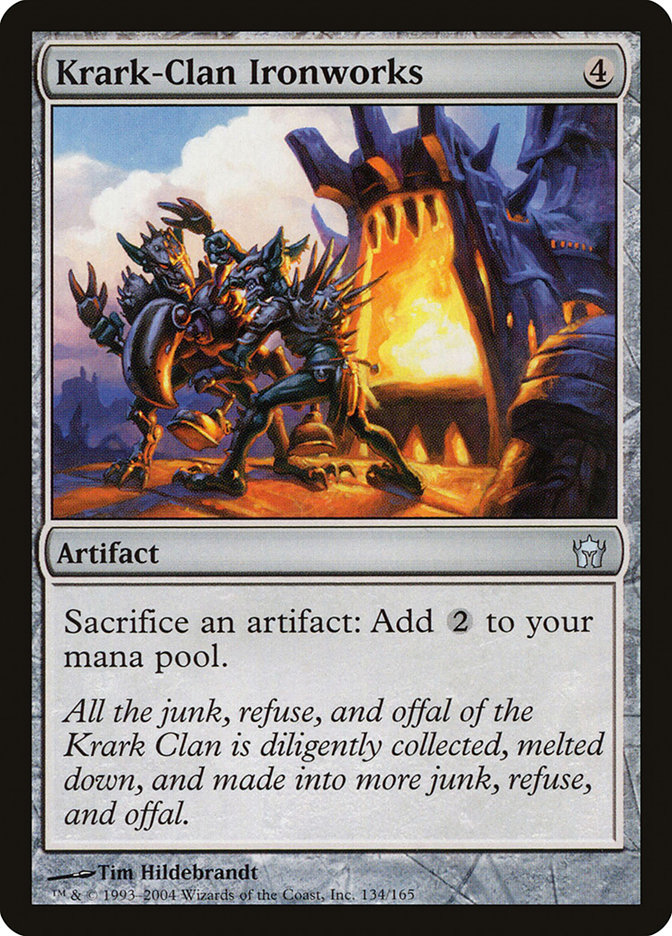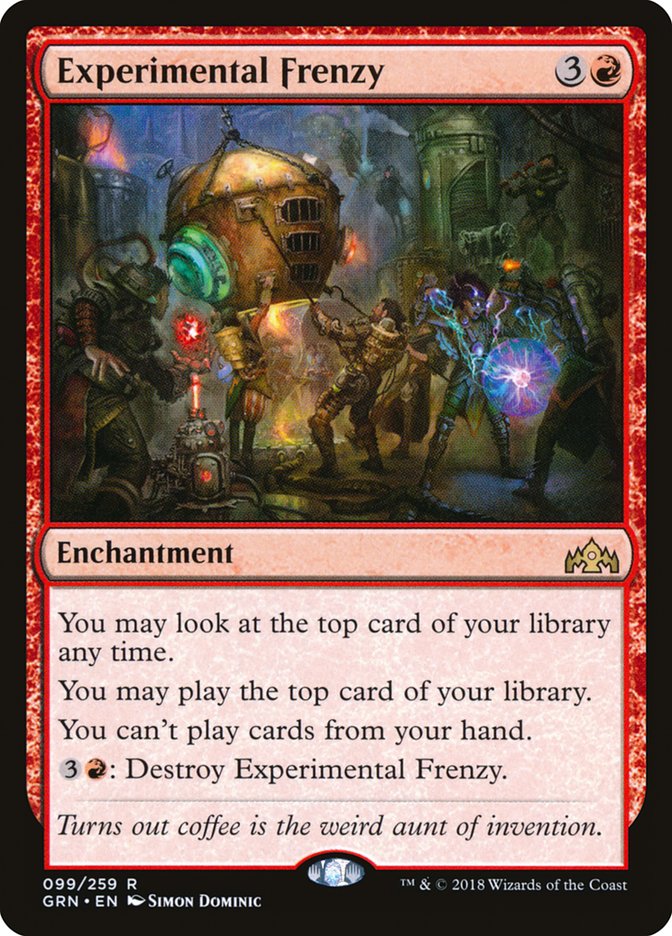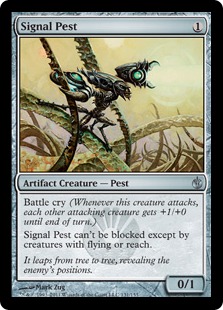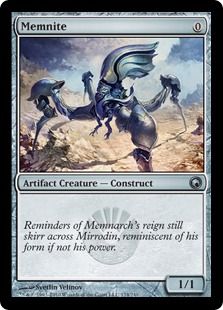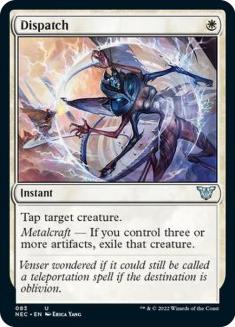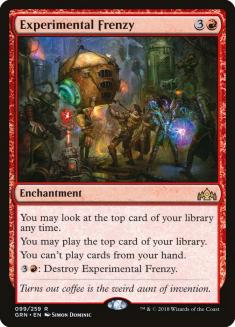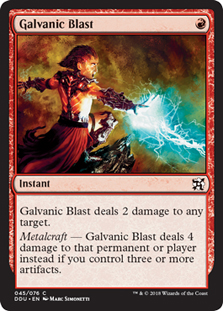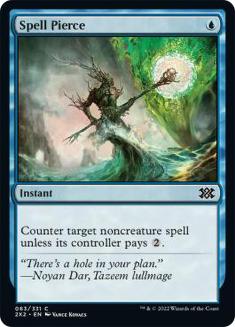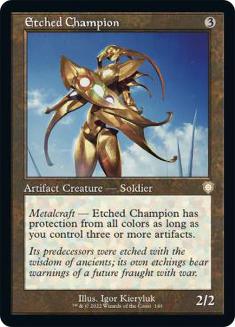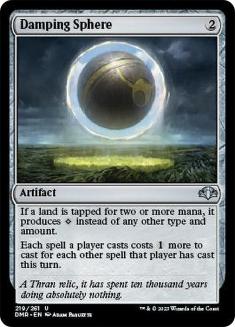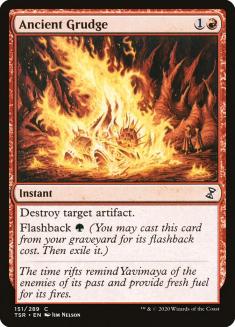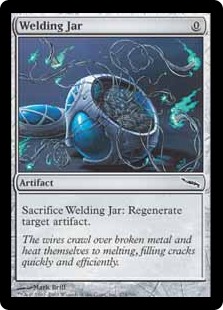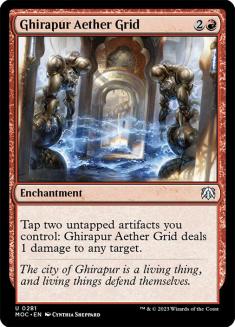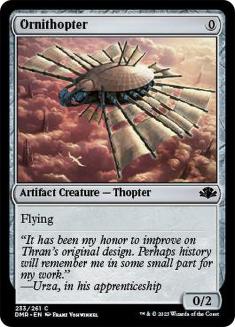Affinity has been a Tier 1 archetype since nearly the inception of the Modern format. It was one of the three best decks in the era of Bloodbraid Elf and Splinter Twin and has continued to rack up numerous results at every level of competition. Lately, however, Affinity has fallen on hard times. In the last few months, it has been almost completely pushed out of the metagame and replaced by its far slower cousin Hardened Scales. However, since the banning of Krark-Clan Ironworks, Affinity has gotten a new lease on life.
Post-Ban Modern
The banning of Krark-Clan Ironworks removed a clear bad matchup for Affinity. The deck struggles to interact with Turn 3-4 combos and was very vulnerable to the horde of 1/1 flyers Sai, Master Thopterist produced. In addition, the deck’s presence caused many different archetypes to up their number of artifact hate cards, indirectly hurting Affinity across the board.
In the wake of the banning, the de facto best deck in Modern is Izzet Phoenix. Phoenix has performed well in nearly every major post-ban tournament, including Grand Prix Los Angeles last weekend. In order to exploit the cantrip-heavy deck, many different Chalice of the Void decks have made a resurgence. Such decks include previously fringe decks like Whir Prison, Colorless Eldrazi, and Mono-Red Prison, all of which have been on the rise in recent weeks. Burn has also been popular, mainly due to the addition of Skewer the Critics and, in some lists, Light Up the Stage.
Dredge continues to be both good and popular, as it also had a bad matchup against Ironworks but sports a hysterically favorable Burn matchup. Disruptive tribal aggro decks like Humans and Bant Spirits exist but are nowhere near the popularity they had at the height of Ironworks’s power. These decks primarily preyed on the artifact combo deck and are extremely vulnerable to Thing in the Ice out of Izzet Phoenix. Grixis Death’s Shadow is bad against a lot of the field, but it remains fundamentally powerful and is propped up by its strong Izzet Phoenix matchup.
In this metagame, Affinity is an excellent choice. The deck has had a favorable Burn matchup since time immemorial and considers Chalice of the Void a minor inconvenience. It’s a slight favorite against all the tribal decks and a substantial favorite against Grixis Death’s Shadow. Its natural predators, blue control decks, have been completely pushed out of the metagame by Dredge, and Storm’s presence has completely fizzled. In addition, the banning means every deck has less artifact hate, which increases Affinity’s percentage across the board. That leaves just two matchups to address: Izzet Phoenix and Dredge.
Enter Experimental Frenzy.
The Weird Aunt of Invention
The Izzet Phoenix matchup most often turns into a grind. While on occasion a fast Awoken Horror or Cranial Plating ends the game, most of the time the Phoenix deck is able to contain Affinity with removal, but then is forced to take a defensive stance with its creatures in order to stay alive. Before Frenzy, these stalemates would always end in Phoenix’s favor because they topdeck useful cantrips instead of irrelevant zero-drops. But with Frenzy, this dynamic is turned on its head.
Now, all the Affinity player needs to do is answer a Thing in the Ice or two and wait for their enchantment to take over the game. Even if they cannot answer it, the rate at which Frenzy produces cards means that the Affinity player may emerge victorious even if they get their battlefield bounced and take a big hit. Thus, it forces the Phoenix player to both answer the Affinity player’s early rush and turn the corner hard to end the game before the unanswerable enchantment shows up. More often than not, the so-called best deck in Modern simply cannot achieve this goal.
Experimental Frenzy also helps substantially against Dredge. Typically, the Dredge games go in one of two ways: either the Dredge player produces a fast clock and the game is a race on a razor’s edge, or they produce a fast Conflagrate and it’s up to the Affinity player to survive it. While Frenzy is usually too slow to matter in the race games, it’s incredible at recovering from Conflagrate. In Games 2 and 3, the enchantment is even more valuable. This is because the Dredge player will usually sideboard in piles of interaction like Ancient Grudge, Darkblast, and Nature’s Claim, while the Affinity player gains access to disruption like Rest in Peace and Spell Pierce. Because both decks are so much better at interacting, Games 2 and 3 are typically much less about racing and much more about grinding. I’m not sure Frenzy is enough to make Dredge a favorable matchup, but I do think it’s close and the artifact deck stands a fighting chance.
While I don’t think Experimental Frenzy fundamentally changed Affinity, I do think it’s by far the best card for its slot. There have been times in Modern when the format was slow enough for Etched Champion, but these days it’s blisteringly fast. Frenzy may look like a grindy card-advantage engine, but it also kills surprisingly quickly.
With only seventeen lands and twelve zero-drops, the red enchantment functions better in Affinity than any other deck in recent memory. It doesn’t hurt that, between Mox Opal and Springleaf Drum, Affinity is capable of casting Frenzy on Turn 3 or even Turn 2, leading to some truly disgusting starts.
Creatures (23)
- 4 Arcbound Ravager
- 4 Ornithopter
- 1 Master of Etherium
- 4 Steel Overseer
- 2 Memnite
- 4 Signal Pest
- 4 Vault Skirge
Lands (17)
Spells (20)

Affinity has not changed much over the years but I will highlight a few details of my list:
- I prefer two copies of Experimental Frenzy maindeck to three. There are a lot of matchups where drawing it early is awkward and it isn’t fundamentally necessary for the deck to operate.
- Historically, I have played four copies of Spire of Industry due to the infrequency with which you need colored mana and how much better Spire is than Glimmervoid on Turn 1. However, right now Burn is just so popular that I feel compelled to play a 3/1 split to hedge on the life payments.
- I think the second Welding Jar is slightly better than the third Memnite, mainly because Memnite often gets sided out while the Jar shines against a lot of the sideboard artifact hate players bring to bear. However, this does make your Springleaf Drums slightly worse in Game 1s.
- I can definitely imagine adding an additional Master of Etherium to up the payoff count, but I don’t know how to make space. Galvanic Blast and Experimental Frenzy are both very important against Izzet Phoenix, and shaving anything else raises the curve and ups the colored spell count.
Piloting Notes
If you’ve been playing Affinity nonstop for years, you can likely skip this section. But if you’re considering picking it up for SCG Regionals or just looking for a refresher, read on.
- Arcbound Ravager is, by far, the most difficult card to play correctly in the deck. The best advice I can give regarding it is this: whether going all-in is correct depends on exactly two pieces of information. You just need to compare the odds your opponent can stop you to the odds you would win if you played out the game normally. All too often, players consider the first piece of information but not the second. If you think your opponent is about 70% to have a spot removal spell, but you’re way behind and only 20% to win a normal game, then you should sacrifice everything to Ravager even though you will probably lose the game on the spot.
- Be aware that with two Ravagers, you can sacrifice one to the other to profit an extra counter. Two Ravagers also allow you to move counters over in two smaller packets in order to play around size-gated removal spells like Gut Shot, Lightning Bolt and Dismember.
- Always think carefully before playing a land. There are scenarios where it’s correct to play each of Blinkmoth Nexus, Inkmoth Nexus, Darksteel Citadel, or a colored source. But few useful heuristics exist. With Inkmoth specifically, think about whether there’s any chance you would want to make it five power next turn to go for the two-turn kill.
- In the dark, cast your zero-drops on Turn 1. Chalice of the Void exists and frequently the possibility of topdecking either Cranial Plating or Mox Opal will make this correct anyway.
- When playing against Cryptic Command, it’s sometimes correct to force them to tap your team, then animate a Nexus and use Cranial Plating’s ability to equip at instant speed. Your opponent can get around this by bouncing the Plating, but denying them the card from Cryptic is often well worth it.
- When you control either Arcbound Ravager or Cranial Plating, it’s sometimes correct to attack with a zero-power Ornithopter. That way, you can move the counters/Equipment onto it in response to a removal spell so you don’t miss damage.
Sideboard Guide
When sideboarding with Affinity, you should keep three factors in mind: colored spells, high drops, and zero-drops. Your colored-spell count will rise after sideboard, as very little good interaction is colorless, but try to keep it in the ten-to-twelve range. In Affinity, a high drop is any card with three or greater converted mana cost. These cards are too expensive to work well in your most broken draws and must be kept to a minimum. You typically want three or at most four in fast matchups but can afford as many as six with the full three Frenzy in slow matchups. As far as zero-drops go, my rule is simple: never cut more than two, as they’re too important for maximizing Mox Opal.
Disclaimer: No guide can hope to cover every matchup in Modern, but I will do my best to cover the most popular decks in the format.
VS Izzet Phoenix
Out:
In:
Most decks should not sideboard in Rest in Peace against Izzet Phoenix, but most decks do not have access to Experimental Frenzy. Affinity has clear inevitability in this matchup and that means you mainly need to focus on not dying. Dispatch comes in as an additional answer to Thing in the Ice and Rest in Peace prevents fast Phoenix draws from being problematic.
VS Grixis Death’s Shadow
Out:
In:
This matchup has always felt very favorable to me, although having fewer Etched Champions in the 75 does hurt. I like leaving small numbers of Galvanic Blast in against Shadow to deal with small Shadows and small life totals. Blast also serves as an additional answer to any Izzet Staticasters or Liliana, the Last Hopes your opponents may sideboard in. I’m not entirely sure whether you want the third Frenzy because of how quickly they turn the corner, but for now I am leaning towards three. Spell Pierce plus Frenzy is awkward, but Shadow is very land-light and countering either Kolaghan’s Command or Temur Battle Rage is amazing.
Be aware that it’s sometimes correct to pass on chip shots in this matchup, as it’s safer to kill your opponent in one massive Plating hit or using Infect damage.
VS Tron
Out (on the play):
In (on the play):
Out (on the draw):
In (on the draw):
The Tron matchup is close and has always been close. The most important piece of advice I can give you about this matchup is: Don’t keep bad hands. While it’s sometimes acceptable in general to keep a hand of consisting of three-power of attackers and a Mox Opal, against Tron you need to have either a real clock or a Damping Sphere.
On the play, I like sideboarding in two Ancient Grudges to attempt to snipe a Turn 1 Expedition Map. While this isn’t incredibly likely, it’s usually game-winning when it occurs.
VS Burn
Out:
In:
Steel Overseer is both fragile and irrelevant in this matchup, as you’ll rarely have a large number of permanents on the battlefield. In general, use Spell Pierce to counter Searing Blaze / Searing Blood and prioritize killing their creatures over deploying more threats. The one exception to this rule is Eidolon of the Great Revel, which you can sometimes turn into a liability for the Burn deck. Be aware that a large Vault Skirge is usually unbeatable in Game 1 but is vulnerable to Path to Exile and Smash to Smithereens in Games 2 and 3.
VS Dredge
Out:
In:
This matchup is pretty straightforward: play around Conflagrate to the best of your abilities and present a fast clock. Keep in mind that while Creeping Chill can throw off racing math, they often sideboard down to fewer copies.
VS Humans
Out:
In:
I’m honestly not sure whether Ghirapur Aether Grid is better or worse than Experimental Frenzy in this matchup, but for now I prefer the cheaper card because games often come down to a race. The most important piece of advice I have for you in this matchup is to prioritize your Ravagers highly. Often, when a Ravager gets bounced, it’s correct to just recast it in two turns rather than sacrifice it for a few paltry counters. The plan of getting in for chip damage and chump blocking while you grow Ravager is often highly effective.
VS Jeskai Control / Azorius Control
Out:
In:
This is one of your worst matchups but your best card by miles is Experimental Frenzy. You should go to any necessary lengths to resolve it, as they are fairly bad at removing it. If you happen not to draw Frenzy, your best plan is to resolve a fast Cranial Plating and pray they don’t have Stony Silence. This isn’t a matchup that rewards playing conservatively because you’re behind at baseline. Thus, I generally cast my Platings into untapped mana and recklessly overcommit into sweepers. Sometimes, you just need to make them have it.
Out:
In:
VS Mirror
Out:
In:
Both matchups are an intricate dance. Every aspect of the game matters: life totals, battlefield presence, poison counters, permanent counts – you name it. Think through your turns and be aware of who the beatdown is always, as it shifts frequently.
***
Going forward, I think Frenzy Affinity is in a great position. I’ll be playing it at GP Tampa as well as SCG Cincinnati and I recommend it to anyone searching for a Modern deck right now. It has strong matchups against many of the top decks and is fundamentally powerful. At the same time, it’s under the radar enough that people are not yet loading up on hate.
In Modern, that’s about as close to a broken deck as you can get.


